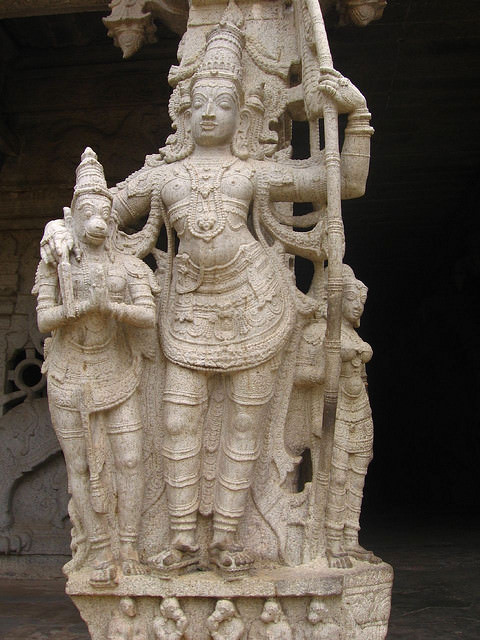Overview
Introduction to Sunderkand
Sunderkand is a significant part of the Hindu epic Ramayana, which is revered and celebrated in different regions of India. It is a chapter that focuses on the adventures of Hanuman, the monkey god, as he embarks on a mission to find and rescue Sita, the wife of Lord Rama. The story of Sunderkand holds immense cultural significance as it showcases the devotion, bravery, and loyalty of Hanuman towards Lord Rama. This chapter is not only a tale of heroism but also serves as a source of inspiration and spiritual guidance for millions of people. The popularity and reverence for Sunderkand can be seen in the various rituals, recitations, and performances that take place in different regions, highlighting its enduring importance in the Hindu religious tradition.
Historical background
The Sunderkand is a significant religious text in Hinduism, particularly in the northern regions of India. It is a chapter from the epic Ramayana, which tells the story of Lord Rama and his journey to rescue his wife Sita from the demon king Ravana. The historical background of the Sunderkand dates back to ancient times, when the Ramayana was composed by the sage Valmiki. This sacred text has been passed down through generations and holds immense importance in Hindu culture. The recitation of the Sunderkand is believed to bring blessings, protection, and spiritual upliftment. It is often performed in religious ceremonies, festivals, and during auspicious occasions. The popularity and cultural significance of the Sunderkand vary across different regions of India, with each region having its own unique traditions and rituals associated with it.
Importance in Hindu mythology
The Sunderkand holds immense importance in Hindu mythology. It is a chapter from the epic Ramayana, which narrates the journey of Lord Hanuman to find and rescue Lord Rama’s wife, Sita, who has been abducted by the demon king Ravana. This chapter is specifically dedicated to Lord Hanuman and his heroic deeds. The Sunderkand is considered sacred and is recited by devotees to seek blessings, protection, and strength. It is believed that reciting the Sunderkand can bring good fortune, remove obstacles, and fulfill desires. The significance of the Sunderkand varies in different regions of India, with various rituals and traditions associated with its recitation.
Sunderkand in North India

Devotion and worship
Devotion and worship play a crucial role in the cultural significance of Sunderkand. This epic is revered and worshipped in different regions for its powerful narrative and spiritual teachings. The devotion of the followers towards Sunderkand is unparalleled, as it serves as a source of inspiration and guidance in their lives. The recitation and chanting of Sunderkand are considered as acts of devotion, believed to bring blessings and protection. The epic’s profound impact on the religious and cultural fabric of various regions is evident through the numerous temples dedicated to Lord Hanuman, the central character of Sunderkand. These temples serve as pilgrimage sites for devotees who seek solace, strength, and divine intervention in their lives. The cultural significance of Sunderkand is deeply rooted in the devotion and worship it inspires among its followers.
Cultural festivals
Cultural festivals play a vital role in celebrating the rich diversity of traditions and customs across different regions. These festivals not only showcase the unique cultural heritage of a particular community but also foster a sense of unity and belonging among its members. One such festival that holds immense cultural significance in various regions is Sunderkand. Sunderkand is a religious event that is celebrated with great fervor and devotion. It is a chapter from the epic Ramayana and is recited in different parts of the country. The recitation of Sunderkand is believed to bring peace, prosperity, and protection from evil forces. People gather in large numbers to participate in this event, which is often accompanied by music, dance, and elaborate decorations. The celebration of Sunderkand not only strengthens the spiritual connection of individuals with their faith but also acts as a platform for cultural exchange and understanding. It serves as a reminder of the shared values and beliefs that transcend regional boundaries and unite people in their devotion to Lord Rama.
Impact on local traditions
The Sunderkand, a chapter from the Indian epic Ramayana, holds significant cultural importance in various regions. Its impact on local traditions is profound. The recitation of Sunderkand, also known as ‘paath’, is a common practice in many households and temples. This sacred ritual is believed to bring blessings and ward off evil spirits. The recital of Sunderkand is often accompanied by elaborate ceremonies and festivities, creating a sense of unity and devotion among the community. The paath is not only a religious practice but also a way to preserve and pass down cultural heritage from one generation to another. It serves as a reminder of the values and teachings of Lord Hanuman, the central character of the Sunderkand. The paath has become an integral part of religious festivals and events, where devotees gather to recite the verses and seek spiritual enlightenment. The popularity of Sunderkand paath has spread beyond its traditional boundaries, with enthusiasts organizing recitals and gatherings in different parts of the world. The impact of Sunderkand on local traditions is evident in the way it has shaped the cultural fabric of communities and continues to be a cherished practice.
Sunderkand in South India
Regional variations
Regional variations of Sunderkand exist in different regions across the globe. The cultural significance of Sunderkand varies greatly depending on the local customs, traditions, and beliefs. In some regions, the recitation of Sunderkand is considered a religious ritual and is performed with great devotion and reverence. In other regions, Sunderkand is celebrated as a cultural event, with music, dance, and theatrical performances. The variations in the way Sunderkand is observed highlight the diversity and richness of different cultures and their unique interpretations of this ancient epic.
Influence on classical music and dance
The Hindu epic Sundara Kanda holds immense cultural significance in various regions. One of its notable influences is on classical music and dance. The rich and vibrant narrative of Sundara Kanda has inspired numerous compositions in classical music, both vocal and instrumental. Renowned composers have created melodic renditions and intricate dance sequences based on the events depicted in this epic. The emotional depth and spiritual essence of Sundara Kanda are beautifully captured through the expressive movements and soulful melodies of classical dance forms like Bharatanatyam and Odissi. The influence of Sundara Kanda on classical music and dance is a testament to its enduring legacy and its ability to transcend time and boundaries.
Temples dedicated to Sunderkand
Sunderkand, a crucial part of the epic Ramayan, holds immense cultural significance in different regions. Temples dedicated to Sunderkand are found in various parts of the country, serving as important pilgrimage sites for devotees. These temples not only showcase the religious devotion towards Lord Hanuman but also serve as a testament to the rich cultural heritage of India. The temples are adorned with intricate carvings and sculptures depicting scenes from the Ramayan, captivating the visitors with their architectural brilliance. The devotees gather at these temples to recite the Sunderkand, seeking blessings and spiritual solace. The popularity of these temples is a testament to the enduring legacy of the Ramayan and the deep-rooted faith of the people.
Sunderkand in East India
Bengali adaptations
Bengali adaptations of Sunderkand hold immense cultural and spiritual significance in the region. The story of Lord Hanuman’s journey to Lanka to rescue Goddess Sita resonates deeply with the Bengali community, who have embraced this epic tale as a symbol of devotion and strength. The Bengali adaptations of Sunderkand often incorporate local traditions and customs, adding a unique flavor to the narrative. It is not uncommon to find recitations of Sunderkand in Bengali households, temples, and cultural events, where devotees gather to seek blessings and find solace in the divine journey of Lord Hanuman. These adaptations serve as a reminder of the timeless appeal and universal message of the Ramayana, transcending regional boundaries and fostering a sense of unity and spirituality among the Bengali people.
Celebrations during Ram Navami
Celebrations during Ram Navami are marked by various religious and cultural activities. One of the significant rituals observed during this time is the SunderKand Path. This path involves the recitation of the SunderKand, a chapter from the epic Ramayana that focuses on the adventures of Lord Hanuman. People gather in temples and homes to participate in the SunderKand Path, which is believed to bring blessings, prosperity, and spiritual upliftment. The path is usually conducted by a learned priest or a group of devotees who chant the verses with devotion and reverence. The recitation is accompanied by the lighting of lamps, offering of prayers, and the distribution of prasad (holy food). It is a time of deep devotion and reflection, as devotees immerse themselves in the divine stories and teachings of Lord Hanuman. The SunderKand Path is not only a religious practice but also a cultural tradition that binds communities together and strengthens their faith in the power of devotion and righteousness.
Sunderkand in West India
Gujarati traditions
In Gujarati traditions, Sunderkand holds an enchanting significance. It is recited in households and temples with great devotion and belief. The recitation of Sunderkand is considered to bring peace, prosperity, and protection from evil forces. The melodious verses and rhythmic chants create a serene atmosphere, captivating the hearts of the listeners. The enchanting power of Sunderkand is believed to cleanse the mind, body, and soul, filling them with positive energy and divine blessings. It is a cherished part of Gujarati culture, passed down through generations, and continues to be celebrated with reverence and enthusiasm.
Impact on folk music and theater
Sunderkand, a chapter from the ancient Indian epic Ramayana, holds immense cultural significance in various regions. One of the major impacts of Sunderkand is on folk music and theater. In the state of Odisha, popularly known as Odia, the chapter has played a pivotal role in shaping the traditional music and theater forms. Odia folk music, with its rich melodies and soulful lyrics, often incorporates verses from Sunderkand, adding depth and spiritual essence to the performances. The theatrical adaptations of Sunderkand in Odia language have captivated audiences for generations, showcasing the vibrant culture and mythology of the region. The influence of Sunderkand on Odia folk music and theater is undeniable, contributing to the preservation and promotion of the cultural heritage of Odisha.
Sunderkand processions
Sunderkand processions are an integral part of the cultural fabric in different regions. These processions are a vivid manifestation of the devotion and reverence towards Lord Hanuman, a prominent character in the epic Ramayan. The processions involve a group of devotees who sing hymns and recite verses from the Sunderkand, a chapter in the Ramayan that narrates the heroic deeds of Lord Hanuman. The atmosphere during these processions is filled with spirituality and enthusiasm, as devotees come together to celebrate the glory of Lord Hanuman. The processions often culminate in a grand finale where the devotees offer prayers and seek blessings from Lord Hanuman. These Sunderkand processions not only strengthen the spiritual bond among the devotees but also serve as a platform for the transmission of cultural traditions from one generation to another.
Sunderkand in Central India
Madhya Pradesh and Chhattisgarh customs
Madhya Pradesh and Chhattisgarh are two states in central India that have a rich cultural heritage. The customs and traditions followed in these states are unique and diverse. When it comes to the significance of Sunderkand, both Madhya Pradesh and Chhattisgarh have their own customs and rituals associated with it. In Madhya Pradesh, Sunderkand is often recited in temples and homes during the auspicious occasion of Hanuman Jayanti. People gather together to chant the verses of Sunderkand and seek blessings from Lord Hanuman. In Chhattisgarh, the recitation of Sunderkand is an integral part of the Dussehra celebrations. It is believed that reciting Sunderkand during this time brings good fortune and prosperity. The customs and rituals followed in Madhya Pradesh and Chhattisgarh showcase the deep-rooted cultural significance of Sunderkand in these regions.
Sunderkand recitals
Sunderkand recitals hold immense cultural significance in various regions across the globe. The practice of reciting Sunderkand, a chapter from the Hindu epic Ramayana, has been deeply ingrained in the religious and spiritual fabric of communities. Delving into the essence of Sunderkand recitals, one can witness the profound impact it has on individuals and communities alike. The recitals not only serve as a means of connecting with the divine, but also as a medium for fostering a sense of unity and devotion among the participants. The rhythmic chants and melodic verses of Sunderkand evoke a sense of tranquility and spiritual awakening, transporting the listeners to a realm of transcendence. Through the recitation of Sunderkand, individuals find solace, enlightenment, and a deeper understanding of the teachings embedded within the epic. This sacred practice continues to thrive, preserving the rich cultural heritage and promoting spiritual growth in different regions.
Religious tourism
Religious tourism plays a significant role in promoting cultural exchange and understanding. One such example is the cultural significance of Sunderkand in different regions. Sunderkand, a chapter from the epic Ramayana, holds immense importance in Hindu mythology. It is believed to bring prosperity, peace, and spiritual enlightenment to those who recite it with devotion. Comprehending Sunderkand involves understanding the heroic journey of Lord Hanuman to find and deliver the message of Lord Rama to Sita, showcasing his unwavering devotion and strength. This sacred text is revered by devotees worldwide and attracts pilgrims from various parts of the world. The popularity of Sunderkand has led to the development of religious tourism in regions where it is celebrated. Travelers and spiritual seekers visit these places to experience the divine aura and seek blessings. The cultural significance of Sunderkand transcends geographical boundaries, connecting people from different backgrounds in their shared reverence for this sacred text.
Author Profile

Latest entries
- 28 June 2025BlogHow to Choose the Best High-Yield Savings Account with 5%+ Interest in India (2025 Guide)
- 28 December 2024BlogTop 6 Employee Management Software for Small Businesses
- 19 December 2024BlogShri Hanuman Chalisa in Hindi Text with English Translation
- 7 August 2024BlogTop 13 Online Master of Social Work Programs

